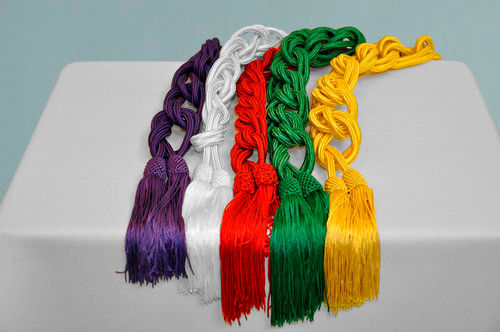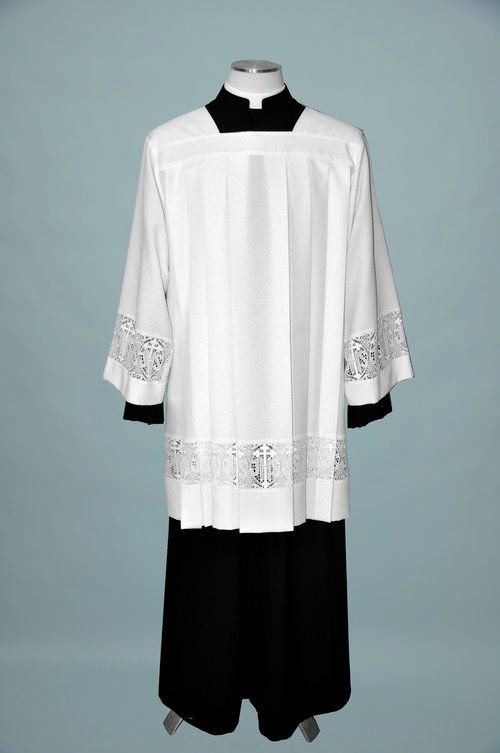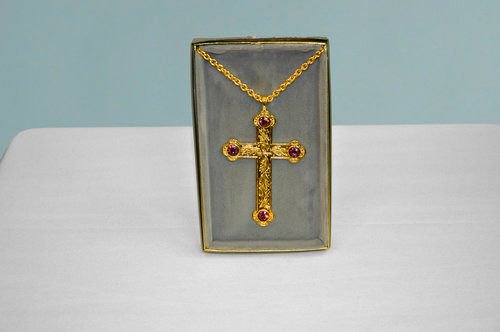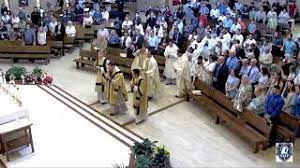Sacred Vestments
- Father Matthew Schreiner
- Jun 30, 2023
- 8 min read
When you see a priest, do you wonder what they are wearing? What is it. They are the sacred vestments, worn by the ministers at mass.
Below: Priest and Deacon vested for mass (source: https://www.patheos.com/blogs/deaconsbench/2014/09/a-dal-what-the-story-behind-the-deacons-vestment/)

Most people during mass see the priest and deacon wearing vestments, as they are called, and do not know their names, and do not understand why we wear them and what they mean. Vestments are an integral part of mass and of the priesthood and diaconate. When you see a priest wear his vestments you know he is a priest, and when you see a deacon wear his vestments you know he is a deacon. This is a concept of a uniform, and the sacred vestments are a uniform. When you see a police officer you can tell by his uniform, same with a priest or deacon.
Below: Diaconate Ordination at the Diocese of Joliet, Priests Deacons and Bishops (credit: https://themokenamarian.com/2021/05/01/a-holy-occasion-bishop-ordains-two-st-mary-seminarians-as-deacons/)

Priests, Deacons, and Bishops all have vestments that are assigned specifically to them. I will explain these vestments in depth but they are:
Amice (Optional)
Alb (Worn by Priests, Deacons and Bishops)
Cinture (Worn by Priests, Deacons and Bishops)
Maniple (Worn sometimes by Priests, Deacons and Bishops)
Stole (Worn by Priests, Deacons and Bishops, but Differs between Priests and Deacons)
Cope (Worn by Priests, Deacons and Bishops)
Dalmatic (Worn by Deacons and by some Bishops)
Chasuble (Worn by Priests and Bishops)
Zucchetto and Birretta (Worn sometimes by Priests, Deacons and Bishops)
Zucchetto, Miter, Pectoral Cross, Bishops Ring, and Shepard's Staff (Worn by Bishops)
Below and Left: Othodox Priest, Bishop, and Deacon, dressed in their Vesture (source: https://www.goarch.org/church-str

ucture/-/asset_publisher/Le8YlyN21ysF/content/praxis-2014-volume-13-issue-3-bishops-priests-and-deacons)
Right: Anglican Ministers (https://www.tonyhj.ca/Priest/faq_priest.html)

Indeed all churches both protestant and in communion and the Eastern Orthodox churches have there own vesture. In a previous article I had shown a few pictures of the Palmarian church, and even they have vestments that are the same as the Catholic church. Many churches such as the Orthodox church have tradition that there vestments are based off. And the Catholic church to has a story behind there vestment.
Vestments worn at Mass
All vestments are also optionally accompanied by prayers
Alb
Pictures of Vestments Below are provided by the House of Hansen based in Chicago, IL

The Alb is a white vestment. Alb comes from the Latin, "albus", meaning white. The Alb is a white vestment it is also the base from which all vestment are worn above. The alb is meant to represent the garment we are clothed in at baptism. The vestment is worn by Priests, Deacons, and Bishops. As well it can also be worn by alter servers, although usually the server alb is not as fancy as a Priest or Deacon or Bishop. There are many different types of albs. They also can have designs, Most Designs on the alb are on the sleeves and near the bottom of the vestment. It is similar to the tunic worn in Jesus's time, and in the time of Jesus, white was what he wore.
Cinture

The cinture is a rope that is worn by the priest, deacon, and bishop. It can also be worn by an altar server. It is meant to hold the alb, but it also keeps the stole in place. The cinture is like a belt. It is tied in a knot. It can sometimes be dependant on the liturgical color especially for the server.
Stole


There are two different types of stoles. The one on the left is worn by priests and bishops. And the one on the left is worn by deacons. A priests stole is usually kept under the stole. Both are important symbols of the office of the priesthood and diaconate. When you see someone wearing one of the stoles you know which office they belong to, the office of the priesthood or the office of the diaconate. They are worn not only for mass but are worn during other sacraments, such as baptism, and confession. It is usually worn under the dalmatic for a deacon, and the chasuble for the priest. It is also worn under the cope. The priest's stole is meant to represent the Yoke of Christ. Christ said my yoke is light and my burden sweat. A yoke goes over the shoulder, so does the stole. The stole is based on the liturgical color which is dependent on the season and feast.
Dalmatic

The dalmatic is the vestment worn by the deacon at mass. It is a vestment with sleeves which is supposed to represent service. The deacon is at service to the bishop, but also to the priest at mass. The bishop will also wear this to show that he is the fullness of holy orders. He wears it under his chasuble as well he only wears it over the priest stole, where as the deacon wears his over the deacon stole. The dalmatic also matches the liturgical color. The bishop's is usually lighter than the deacons since it is worn with many vestments.
Chasuble


The Chasuble is final vestment worn by a priest and bishop. There are several styles but the two most common are Gothic and Roman. The roman style is on the right, and the Gothic style is on the left. The Roman style is the older style traditionally used in the Tridentine/Latin mass. The Gothic style has many different designs and looks different depending on where you purchase it. It also depends on the liturgical color. Depending the deacon and priest may have matching dalmatics and chasubles.
Other Vestments
Amice
The amice is a white vestment that is optionly worn under the alb. It is usally worn under a certain type of alb that has a square neck. It represents putting on a new man.
Maniple, Chalice Veil, and Burse

The maniple which is shown on the far left, is a vestment that depends on the liturgical color, and is worn on the left arm. It is traditionally worn at the Tridentine mass, but can be worn in the Novus Ordo Mass. It is supposed to represent service, like if you go to a restaurant the waiter will have a towel on his arm. It can be worn by the priest, deacon, or bishop. The Chalice Veil and burse also depend on the liturgical color, and is traditionally used at the Tridentine mass, but can be used at the Novus ordo mass. But a simple white chalice veil can be used at any time, regardless of season. It is usually only used by priests and bishops who use chalices.
Choir Dress

Choir dress or choir cassock is the outfit worn by a bishop or priest who is not celebrating or con-celebrating mass. It consists of a cassock, surplice, and shoulder cape. The shoulder cape is usually worn only by the bishop, and above it can be worn a stole.
Surplice

The surplice is worn over the cassock. It is usually worn by alter servers and acolytes, as well priests and deacons can wear it. It can be worn during yhe sacraments with a stole and it can be used with the cope. It is like s shorter version of the alb
Cope

The cope is worn during events not in mass (although for some events in mass it may be worn, or by a con-celebrating priest). It is usually worn during adoration and can be worn during baptisms and other sacraments. It is worn by priests and in occasions by deacons. It is worn with a stole and a alb or surplice. It can also be dependent on the liturgical color for certain events, otherwise a white one is worn.
Zucchetto

The Zucchetto is usually only worn by a bishop. It can also occasionally be worn by a priest. It is worn under the biretta, mitre, at mass, during sacraments, with a cassock, and with choir dress. It also depends on color. Different ministers have different colors of which they wear with cassock, zucchetto, and biretta. A priest and deacon wear black, a bishop or archbishop wear purple, and the cardinal will wear red. It is similar to a Jewish Yamaka, and what it symbolizes is God's protection over us how he is always present over us.
Biretta



The Biretta is usually worn in the Tridentine mass, but can be worn during the Novus Ordo Mass. It can be worn by priest, deacon, and bishop. A bishop's usually is solidly his liturgical color, but he can have a black one with the fuzz on top being his color. There are four or three bridges, and some do not have the fuzz on top and these are usually worn by cardinals.
Miter


The miter is a vestment worn only by a bishop or cardinal and it is only worn during mass. It can match the liturgical color or it can be just plain white. It can have a design or not. It does over the zucchetto, and is worn with the zucchetto.
Pectoral Cross

The Pectoral cross is worn by the Bishop at mass and with his cassock or collared shirt. It is usually worn with a metal chain with the cassock and collared shirt and a rope cord at mass. It is usually worn under the chasuble/dalmatic of a bishop, but it can be worn over the chasuble. It has many designs that can be worn. Anything from a crucifix to any symbol of Christ and the church.
Bishop's Ring

The bishop's ring is usually a gem in a metal ring, usually with symbols of the cross. It is worn on the right ring finger. It symbolizes the bishop's marriage to the church and his diocese. It is worn during mass, and is kept on for the whole mass (except during the washing of the hands), unlike other of the bishops vestments which are removed (the mitre and zucchetto).
Shepard's Staff

On the left you see a bishop celebrating Confirmation. So far we have discussed a lot of the vestments but we have not seen an actual bishop wearing these vestments. Now the bishop in the photo is not wearing the dalmatic. And also there is a vestment I did not mention which he is not wearing. The shepherds staff which he is holding in his right hand, is supposed to represent a Shepard. Jesus Called himself the Good Shepard. A Shepard uses his staff to bring back lost sheep. The Bishop (although please note the bishop in the picture is retired, but the meaning of the vesture is still the same, although you may not consider the shepherds staff a vestment, we do) is the Shepard of his flock that is the diocese. He uses this staff to symbolize his power. It can be very fancy or very simple like the one in the picture.
Cassock and Collared Shirts



I have shown a few pictures of cassocks and one of the collared shirts. There are many types of cassocks and collared shirts. The collared shirt is on the left and the cassocls are on the right. They are of course an easy way to tell if someone is a priest or not. On the right their is a picture of a cardinals cassock, he is wearing a cassock with red piping, and a red cape, as well he has a zuchetto, its hard to see though. The top left cassock (as well as the bottom is a roman cassock. The collar is called a Roman collar. Again ther are many tyoes including tabs and caollars, both which look basically thte same. None of the above are tabs. They are all the basis of the vestments. And they are under the vestments. It is the basic things that a priests wears, and you can tell a priest by it. As well a deacon can wear a collared shirt and at mass a cassock. The meaning of the collars to remind the priest of his mission, and of Jesus Christ the great priest, and remind him he is his brother-priest.

In conclusion the Sacred Vestments are very important part of the mass, as well as the sacred vessels. Both of which are talked about in the General Instruction of the Roman Missal. Both the priest and the deacon are core to the celebration of the mass. And you can tell them based on how they are dressed. You now know what

each of these vestments are and can identify them You can correctly identify who is a priest, deacon, and bishop. Whether you attend the Tridentine or Novus Ordo mass, or online mass, these vestments are still core to theses celebrations. Who knows maybe you can show off you knowledge to your friends or impress you priest.
I do not know how much more this is to explain about the church. I'm sure there is more. Again an article a day.
Father Matthew Schreiner
Kosciol Church
Special Thanks to Father Brian Geary, I know a lot of this information because of you, and did not have to do as much research (I included a few pictures of him in vesture)


Comments